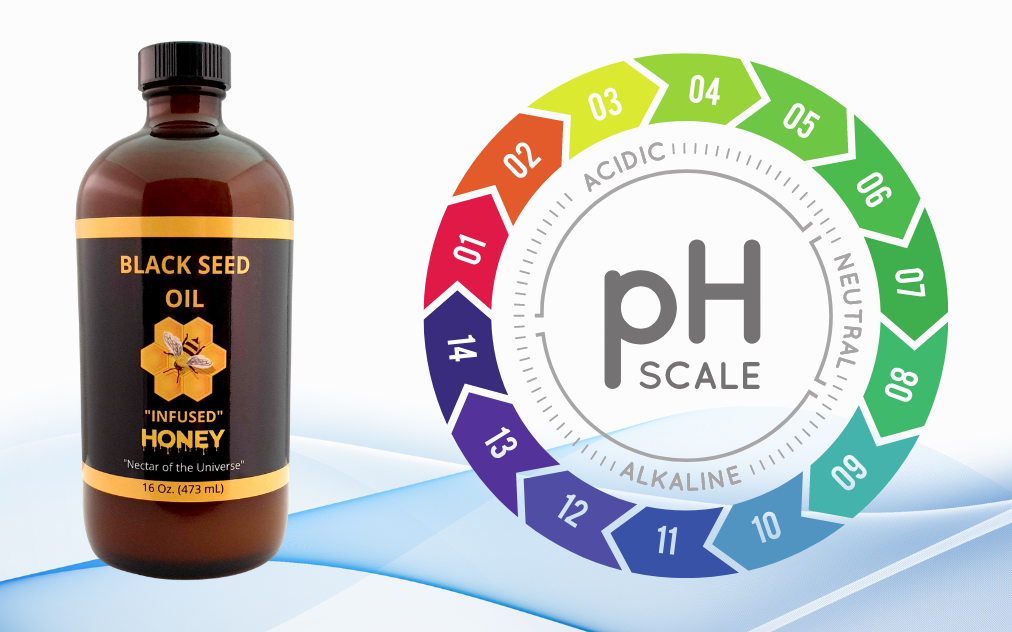Many of us have heard of pH and know that it has something to do with the acidity or alkalinity of a substance. The pH of foods and substances, particularly when consumed, can have varying impacts on the body.
What exactly is pH?
The p in pH stands for “potential” or “power,” which refers to the calculation to find the acidity or alkalinity of a solution. The H stands for hydrogen, the chemical element that plays a crucial role in determining the acidity of the substance. The scale (typically) goes from 0 to 14, with 0 being the most acidic (considered low) and 14 (considered high) being the least acidic (or more alkaline). 7 is considered neutral. Acidic foods tend to taste sour, and alkaline foods can taste salty or bitter.
Lemons, limes, and oranges tend to have a low pH, and foods like potatoes, beets, and carrots have a higher pH. Pure water tends to be neutral.
As a side note, the pH scale can both go below 0 and above 14, but for the purposes of this blog, we will stay within the 0 to 14 range.
PH value and your body
The foods we eat can have an effect on the pH levels in our bodies, particularly in the blood. The pH of the blood is strictly regulated by the body within a small range of 7.35 to 7.45, which is slightly alkaline. This range is crucial for the normal functioning of many biological systems in the body, including enzyme activity, oxygen transport, and nerve function.
When we eat anything, it is digested and broken down into its constituent elements, which include acids and bases. The kidneys and lungs, which serve to eliminate excess acids and bases from the body, are two of the body’s processes for maintaining blood pH. When we eat acidic foods like citrus fruits, for example, the body releases bicarbonate ions into the circulation to neutralize the acids and maintain a normal pH balance.
While the body has the ability to manage its pH balance, some individuals feel that eating an alkaline diet can assist in maintaining a slightly alkaline pH and promote good health. Nevertheless, scientific data supporting this assertion is still limited, and it is critical to have a balanced diet that includes a range of nutrient-dense foods, regardless of pH level.
It’s also worth mentioning that the pH levels in different physiological areas can vary greatly, with the stomach, for example, having a high acidic pH to help digestion. As a result, the optimal pH level for the body might vary depending on the location of the body being evaluated.
Benefits of acidic foods:
Foods with a pH of 4.6 or below are termed acidic, and they offer various advantages, including:
Food preservation and safety: Low pH levels in foods aid in preservation by limiting the growth of bacteria, yeasts, and molds. This is why many canned foods and pickled vegetables are 4.6 or lower. Low pH levels in meals can also assist in inhibiting the growth of bacteria that cause sickness, such as Salmonella and E. coli.
Flavor: Acidity may improve the flavor of some foods, such as citrus fruits, vinegar, and wine.
Improved digestion: Acidic foods can help with digestion by breaking down proteins and other complex compounds in the stomach. Several cuisines employ acidic substances in marinades and sauces, such as lemon juice or vinegar. Certain nutrients, such as iron and calcium, are more easily absorbed by the body in an acidic environment. This means that eating acidic foods can aid in the absorption of these nutrients.
Benefits of an alkaline diet:
An alkaline diet consists of eating foods that are known to help maintain a slightly alkaline level in the body, which is thought to promote health. While scientific evidence for the benefits of an alkaline diet is currently sparse, here are some of the possible advantages of eating alkaline foods:
Bone and kidney health: Eating alkaline foods may assist in enhancing bone health by minimizing calcium loss from bones. Alkaline diets may assist in enhancing kidney function by lowering the chance of kidney stones.
Weight reduction and digestive health: Consuming alkaline foods may assist in improving digestive health by lowering inflammation in the digestive tract. Some supporters of the alkaline diet suggest that eating alkaline foods can aid in weight reduction. This might be due to the fact that many alkaline foods are low in calories and high in fiber, which can enhance feelings of fullness and lower calorie consumption.
The pH of BSO Honey
When measured using a digital pH reader, BSO Honey had an average of 3.8. Each constituent in BSO Honey has its own pH, and those numbers can vary depending on several factors.
Here are the average pH levels of each of BSO Honey’s constituents:
Cold-pressed Black Seed Oil: The pH of cold-pressed black seed oil is typically around 6.0 to 7.0, which is considered slightly acidic to neutral.
Raw Honey: The pH of raw honey can range from 3.4 to 6.1, depending on the type and source of the honey. Most types of honey are acidic, typically between 3.4 and 4.5.
Apple Cider Vinegar: The pH of apple cider vinegar typically ranges from 2.5 to 3.7, which is highly acidic. The acidity of apple cider vinegar is due to the presence of acetic acid, which gives its tart taste.
Due to its acidity BSO Honey has a good shelf life and will not grow mold or bacteria.
If you want to learn more about BSO Honey and how it can improve your health check out our previous blogs! We discuss a wide range of health topics. If you have something you would like us to discuss, feel free to leave your suggestion in the comments below!

